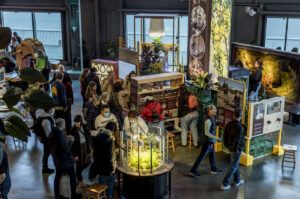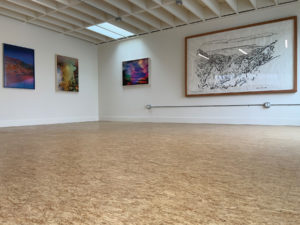
When Ashwini Bhat arrived in California in 2013, the first people she met were creators like her. “I met artists living in communities deep in the woods; I met them in the city,” she remembers. “I was a foreigner, but I felt welcomed by these communities.” After her initial artist residency at Flynn Creek Pottery in Comptche, Mendocino County, Bhat spent several years traveling around the country, hopping from residency to residency. She eventually moved to California permanently in September 2017, having fallen in love with the state’s intellectual and artistic energy.
Growing up in a small agrarian community in southern India, Bhat had felt close to the natural world. But she also felt stifled there by her community’s gender roles and expectations. “The dreams I had of an intellectual and artistic life seemed all but unreachable from there,” she explains. California was the first place where she felt like she truly belonged.
Then came the fires. All of Bhat’s belongings were still in four boxes, yet to be unpacked, when the Tubbs Fire began burning north of Petaluma in October 2017. The upheaval “was like jumping into the deep end for me,” she says. Understandably, she’s still affected by that experience and by the many other fires she has lived through in the past four years. “I should be enjoying the beautiful spring weather right now,” she told me in a call from her studio this past April, “but there is a part of me which is already worrying about this year.”
On top of the tragedy of the fire, as a new resident to California Bhat also found herself surrounded by a natural world that was unfamiliar. It was a disorienting change from the feeling of intimacy with the land that she had valued so much growing up. When she met Beat poet Gary Snyder at his house in the Sierra foothills in 2020, she was struck by how he “knows every inch” of the land he lives on, she says. “I’m super envious of that kind of attention to detail and sense of belonging in the land. Ten years from now I would like to know at least 30 percent of things around me.”
Bhat has long felt an affinity to fire. As a clay sculptor, she needs it to strengthen and complete her artworks, and the traditional collective tending of kiln fires has always been a source of community and a sense of belonging. Through her art, California’s wildfires have become a way to deepen her own sense of place.
Not long after the Tubbs Fire, Bhat began accompanying wildlife biologist, poet, and filmmaker Maya Khosla on trips to study biodiversity in post-fire forests. Khosla opposes the practice of “salvage logging” in forests affected by wildfire. She seeks to show in her work that these environments are rich in life and advantageous to some species’ survival. As they traveled together, Bhat was taken by Khosla’s focus and her attentiveness to the forest. “I could see so much beauty,” she says of the burnt forests they visited on a trip to the Stanislaus National Forest adjacent Yosemite.
Bhat began integrating what she encountered during these trips into an ongoing series called Assembling California, named for John McPhee’s book of that title. With this series, she creates abstract sculptures that reference the geology and ecosystems of California. Wildfires and post-fire landscapes are a central component, including Yosemite and the Sierra Nevada and the Tubbs and 2019 Kincade fires.
“Assembling California: Post-fire Yosemite” is a bulbous clay sculpture with a dense base composed of several cylindrical forms warped and fused together, with yellow, ribbonlike forms that emerge and encircle the sculpture. Another work, “Assembling California: Post-fire Sierras,” is similarly shaped, but in this earth-toned piece the elements seem to grow more apart than together. Viewed side by side, the sculptures nod to the uncertainty of post-fire landscapes, which regenerate and transform based on their own particular characteristics. The organic forms, which might recall trees and invertebrates, are not inert; life emerges from the destruction of these fires.
Prior to Tubbs, Bhat’s sculptures were more discrete and bounded, often taking the form of single geometric forms. Now, her work shows more unpredictability and liveliness. For Bhat, who doesn’t see a separation between her artistic practice and her daily life, this evolution mirrors the unpredictable dynamism of her life in California.
And in places, it reminds Khosla of the shelf fungi that consume old trees and the tiny spaces in post-fire snags where animals make their homes. “It’s all about what has given way,” she says, “and what’s going to rise.”




